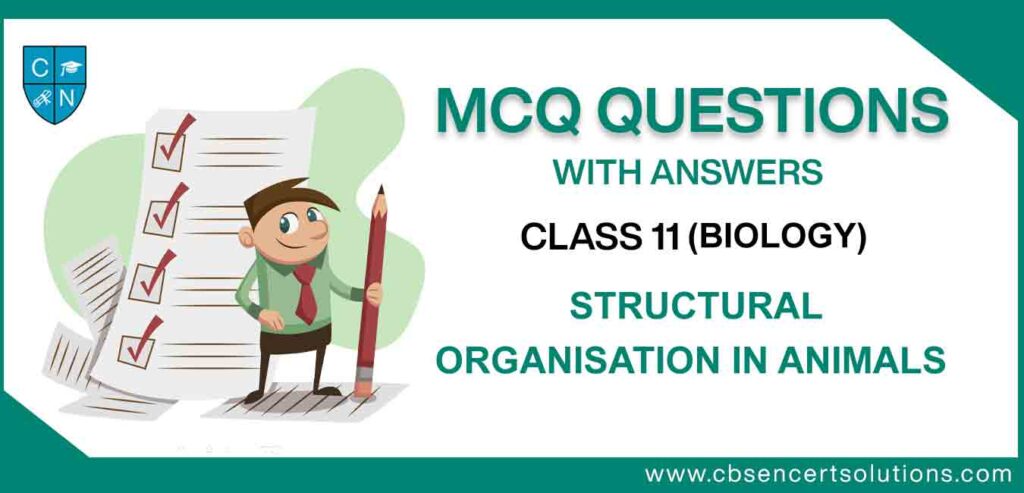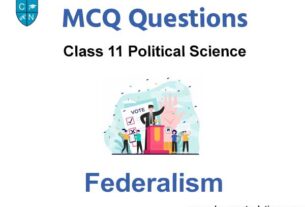Students can refer to the following Structural Organisation in Animals MCQ Questions for class 11 with Answers provided below based on the latest curriculum and examination pattern issued by CBSE and NCERT. Our teachers have provided here collection of multiple choice questions for Chapter 1 Structural Organisation in Animals Class 11 Biology covering all topics in your textbook so that students can assess themselves on all important topics and thoroughly prepare for their exams
Structural Organisation in Animals MCQ Questions for class 11 Biology with Answers
We have provided below Structural Organisation in Animals MCQ Questions for class 11 with answers which will help the students to go through the entire syllabus and practice multiple choice questions provided here with solutions. As MCQ Questions for Class 11 Biology pdf download can be really scoring for students, you should go through all problems provided below so that you are able to get more marks in your exams.
Structural Organisation in Animals MCQ Questions for class 11
Question. The body cells in cockroach discharge their nitrogenous waste in the haemolymph mainly in the form of
(a) urea
(b) calcium carbonate
(c) ammonia
(d) potassium urate.
Answer
D
Question. The terga, sterna and pleura of cockroach body are joined by
(a) arthrodial membrane
(b) cartilage
(c) cementing glue
(d) muscular tissue.
Answer
A
Question. Cuboidal epithelium with brush border of microvilli
is found in
(a) lining of intestine
(b) ducts of salivary glands
(c) proximal convoluted tubule of nephron
(d) Eustachian tube
Answer
C
Question. Goblet cells of alimentary canal are modified from
(a) squamous epithelial cells
(b) columnar epithelial cells
(c) chondrocytes
(d) compound epithelial cells.
Answer
B
Question. Choose the correctly matched pair.
(a) Tendon – Specialized connective tissue
(b) Adipose tissue – Dense connective tissue
(c) Areolar tissue – Loose connective tissue
(d) Cartilage – Loose connective tissue
Answer
C
Question. Choose the correctly matched pair.
(a) Inner lining of – Ciliated epithelium salivary ducts
(b) Moist surface – Glandular epithelium of buccal cavity
(c) Tubular parts of -Cuboidal epithelium nephrons
(d) Inner surface of – Squamous epithelium bronchioles
Answer
C
Question. Identify the tissue shown in the diagram and match with its characteristics and its location.
(a) Smooth muscles, show branching, found in the wall of the heart
(b) Cardiac muscles, unbranched muscles, found in the walls of the heart
(c) Striated muscles, tapering at both-ends, attached with the bones of the ribs
(d) Skeletal muscles show striations and are closely attached with the bones of the limbs
Answer
D
Question. The supportive skeletal structures in the human external ears and in the nose tip are examples of
(a) ligament
(b) areolar tissue
(c) bone
(d) cartilage.
Answer
A
Question. The ciliated columnar epithelial cells in humans are known to occur in
(a) Eustachian tube and stomach lining
(b) bronchioles and Fallopian tube
(c) bile duct and oesophagus
(d) Fallopian tube and urethra.
Answer
B
Question. The kind of tissue that forms the supportive structure in our pinna (external ears) is also found in
(a) nails
(b) ear ossicles
(c) tip of the nose
(d) vertebrae.
Answer
C
Question. Which one of the following pairs of structures distinguishes a nerve cell from other types of cell?
(a) Vacuoles and fibres
(b) Flagellum and medullary sheath
(c) Nucleus and mitochondria
(d) Perikaryon and dendrites
Answer
D
Question. In which one of the following preparations are you likely to come across cell junctions most frequently?
(a) Thrombocytes
(b) Tendon
(c) Hyaline cartilage
(d) Ciliated epithelium
Answer
D
Question. Ligament is a/an
(a) inelastic white fibrous tissue
(b) modified white fibrous tissue
(c) modified yellow elastic fibrous tissue
(d) none of the above.
Answer
C
Question. Four healthy people in their twenties got involved in injuries resulting in damage and death of few cells of the following. Which of the cells are least likely to be replaced by new cells?
(a) Liver cells
(b) Neurons
(c) Malpighian layer of the skin
(d) Osteocytes
Answer
B
Question. Mast cells of connective tissue contain
(a) vasopressin and relaxin
(b) heparin and histamine
(c) heparin and calcitonin
(d) serotonin and melanin.
Answer
B
Question. Which one of the following contains the largest quantity of extracellular material ?
(a) Striated muscle
(b) Areolar tissue
(c) Stratified epithelium
(d) Myelinated nerve fibres
Answer
B
Question. Earthworms have no skeleton but during burrowing,the anterior end becomes turgid and acts as a hydraulic skeleton. It is due to
(a) gut peristalsis
(b) setae
(c) coelomic fluid
(d) blood.
Answer
C
Question. Earthworms are
(a) ammonotelic when plenty of water is available
(b) ureotelic when plenty of water is available
(c) uricotelic when plenty of water is available
(d) uricotelic under conditions of water scarcity.
Answer
A
Question. Primary function of enteronephric nephridia of Pheretima is
(a) osmoregulation
(b) excretion of nitrogenous wastes
(c) respiration
(d) locomotion.
Answer
A
Question. Smooth muscles are
(a) involuntary, fusiform, non-striated
(b) voluntary, multinucleate, cylindrical
(c) involuntary, cylindrical, striated
(d) voluntary, spindle-shaped, uninucleate.
Answer
A
Question. Which type of tissue correctly matches with its location?
Tissue Location
(a) Transitional Tip of nose epithelium
(b) Cuboidal epithelium Lining of stomach
(c) Smooth muscle Wall of intestine
(d) Areolar tissue Tendons
Answer
C
Question. The function of the gap junction is to
(a) separate two cells from each other
(b) stop substance from leaking across a tissue
(c) performing cementing to keep neighbouring cells together
(d) facilitate communication between adjoining cells by connecting the cytoplasm for rapid transfer of ions, small molecules and some large molecules.
Answer
D
Question. Collagen is
(a) fibrous protein
(b) globular protein
(c) lipid
(d) carbohydrate.
Answer
A
Question. During an injury nasal septum gets damaged and for its recovery which cartilage is preferred?
(a) Elastic cartilage
(b) Hyaline cartilage
(c) Calcified cartilage
(d) Fibrous cartilage
Answer
B
Question. Which cells do not form layer and remains structurally separate?
(a) Epithelial cells
(b) Muscle cells
(c) Nerve cells
(d) Gland cells
Answer
C
Question. Proteoglycan in cartilages which is a part of polysaccharide is
(a) chondroitin
(b) ossein
(c) casein
(d) cartilagin.
Answer
A
Question. The cells lining the blood vessels belong to the category of
(a) smooth muscle tissue
(b) squamous epithelium
(c) columnar epithelium
(d) connective tissue.
Answer
B
Question. The cell junctions called tight, adhering and gap junctions are found in
(a) connective tissue
(b) epithelial tissue
(c) neural tissue
(d) muscular tissue.
Answer
B
Question. Characteristic of simple epithelium is that they
(a) are arranged indiscriminately
(b) make a definite layer
(c) continue to divide and help in organ function
(d) none of the above.
Answer
B
Question. In mammals, histamine is secreted by
(a) lymphocytes
(b) mast cells
(c) fibroblasts
(d) histiocytes.
Answer
B
Question. Protein present in cartilage is
(a) cartilagin
(b) ossein
(c) chondrin
(d) none of these.
Answer
C
Question. Basement membrane is made up of
(a) no cell product of epithelial cell
(b) epidermal cell only
(c) endodermal cell
(d) both (b) and (c).
Answer
A
Question. Stratum germinativum is an example of which kind of epithelium?
(a) Columnar
(b) Squamous
(c) Cuboidal
(d) Ciliated
Answer
A
Question. The ciliated epithelial cells are required to move particles or mucus in a specific direction. In humans, these cells are mainly present in
(a) bronchioles and Fallopian tubes
(b) bile duct and bronchioles
(c) Fallopian tubes and pancreatic duct
(d) Eustachian tube and salivary duct.
Answer
A
Question. Match the following cell structure with its characteristic feature.
(A) Tight junctions
(i) Cement neighbouring cells together to form sheet
(B) Adhering junctions
(ii) Transmit information through chemical to another cells
(C) Gap junctions (iii) Establish a barrier to prevent leakage of fluid across epithelial cells
(D) Synaptic junctions
(iv) Cytoplasmic channels to facilitate communication between adjacent cells
Select correct option from the following.
(A) (B) (C) (D)
(a) (ii) (iv) (i) (iii)
(b) (iv) (ii) (i) (iii)
(c) (iii) (i) (iv) (ii)
(d) (iv) (iii) (i) (ii)
Answer
C
Question. An epithelial tissue which has thin flat cells, arranged edge to edge so as to appear like closely packed tiles, is found to be present at
(a) outer surface of ovary
(b) inner lining of Fallopian tube
(c) inner lining of stomach
(d) inner lining of cheeks.
Answer
D
Question. Hair present in the skin are
(a) epidermal in origin and made of dead cells
(b) epidermal in origin and made of living cells
(c) dermal in origin and made of living cells
(d) dermal in origin and made of dead cells.
Answer
A
Question. The layer of actively dividing cells of skin is termed as
(a) stratum compactum
(b) stratum corneum
(c) stratum malpighii/stratum germinativum
(d) stratum lucidum.
Answer
C
Question. Tendon is made up of
(a) yellow fibrous connective tissue
(b) modified white fibrous tissue
(c) areolar tissue
(d) adipose tissue.
Answer
B
Question. Areolar connective tissue joins
(a) bones with bones
(b) fat body with muscles
(c) integument with muscles
(d) bones with muscles.
Answer
C

Our teachers have developed really good Multiple Choice Questions covering all important topics in each chapter which are expected to come in upcoming tests and exams, as MCQs are coming in all exams now therefore practice them carefully to get full understanding of topics and get good marks. Download the latest questions with multiple choice answers for Class 11 Structural Organisation in Animals in pdf or read online for free.
The above NCERT based MCQs for Class 11 Structural Organisation in Animals have been designed by our teachers in such a way that it will help you a lot to gain an understanding of each topic. These CBSE NCERT Class 11 Structural Organisation in Animals Multiple Choice Questions have been developed and are available free for benefit of Class 11 students.
Advantages of Structural Organisation in Animals MCQ Questions Class 11 Biolgy with Answers
a) Structural Organisation in Animals MCQ Questions for class 11 will help the kids to strengthen concepts and improve marks in tests and exams.
b) Multiple Choice Questions for Structural Organisation in Animals Class 11 have proven to further enhance the understanding and question solving skills.
c) Regular reading topic wise questions with choices will for sure develop very good hold over each chapter which will help in exam preparations.
d) It will be easy to revise all Structural Organisation in Animals chapters and faster revisions prior to class tests and exams.
Free Printable MCQs in PDF of CBSE Class 11 Structural Organisation in Animals are designed by our school teachers and provide best study material as per CBSE NCERT standards.
You can easily get MCQs for Structural Organisation in Animals from https://www.cbsencertsolutions.com
The MCQs for Class 11 Structural Organisation in Animals with Answers have been developed based on current NCERT textbook issued by CBSE.
MCQs cover the topics of all chapters given in NCERT Book for Class 11 Structural Organisation in Animals.
Yes – These Multiple Choice Questions for Class 11 Structural Organisation in Animals with Answers are free to print and use them later.
No – All MCQs for Structural Organisation in Animals are free to read for all students.
Just scroll and read the free MCQs.
Yes – you can download free MCQs in PDF for Structural Organisation in Animals in standard MCQs format with Answers.
